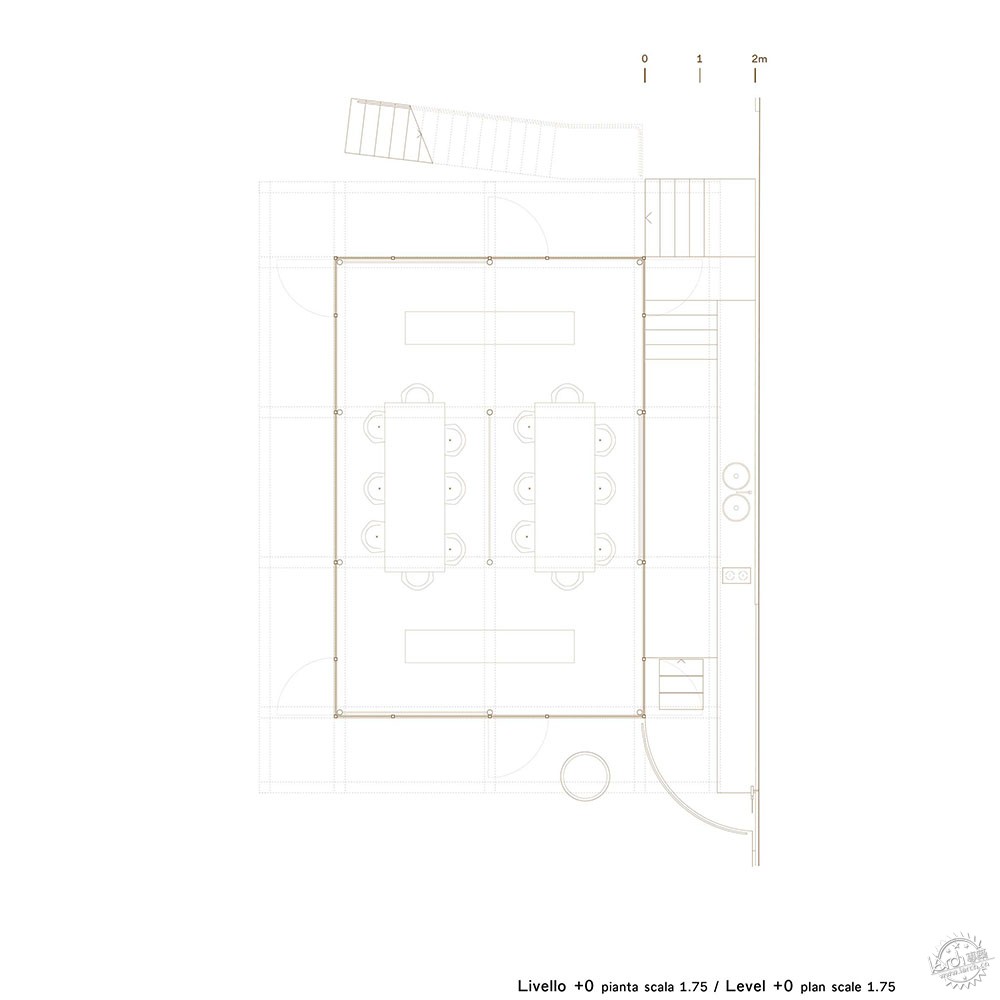
旧工厂内的工作室
AMAA creates own studio by inserting huge glass box inside old Italian factory
由专筑网王帅,小R编译
威尼斯AMAA事务所将一座废弃的管道工厂的厂房改造成为一间粗糙而不失细腻的建筑工作室。
AMAA事务所的创始人Marcello Galiotto和Alessandra Rampazzo,他们在意大利威尼托地区西部Arzignano的一座旧工厂内,插入一座钢框架的两层玻璃空间。
Venetian office AMAA has converted an abandoned plumbing factory into an architecture studio with a rough-and-ready character.
AMAA founders Marcello Galiotto and Alessandra Rampazzo created their new workplace by inserting a steel-framed, two-storey glass volume inside the old factory in Arzignano, a town in the west of Italy's Veneto region.

这对建筑师夫妇尽他们一切努力来维持这座建筑的工业特性。因此,他们不仅使结构尽可能完整,同时还设计了其它配件。
新的工字钢表面锈迹斑斑,正如房顶的框架。而浇筑的混凝土元素与现有的地板融为一体。
The pair did all they could to preserve the building's industrial character. So not only did they leave the structure as intact as they could, they also designed their insertions to match.
New steel I-beams are just as rusty as the factory's ceiling framework, while poured concrete elements blend with the existing floor.

他们告诉Dezeen的记者:“我们希望尽可能地保留建筑的原始结构,强调现在和过去的关联性。”
“我们设计了一座独立的空间,寻求与建筑物现有拱顶的几何形状材料构成联系,这些材料有水泥、钢、波纹金属、玻璃和木材。”
"We wanted to preserve the original structure as much as possible, in order to enhance the relationship with the past," they told Dezeen.
"We designed an independent box that seeks relationships with the geometries of the building's existing vaults and its materials: cement, steel, corrugated metal, glass, wood."

新的两层建筑位于工厂大厅中央,新结构远离四周的围墙,内部设置了工作空间和图书馆。所有墙壁都由玻璃制成,确保空间像翻新前一样轻盈和开放。
建筑师表示:“细长的钢结构元素定义了新结构的骨架,也定义了窗框的四周,在现有空间和新结构之间保持较好的透明度。”
The new two-storey structure sits in the centre of the factory hall, set back from all of the walls, housing workspaces and a library. All of its walls are made from glass, ensuring that the space feels as light and open as it did before the renovation.
"Slender steel elements define the structural skeleton of the volume but also the perimeter of the window frames, which maintains a complete transparency between the existing space and the addition," said the architects.

一层的空间略小,增大了地面四周的活动空间。
上面的空间面积大约是下层的两倍,上层的悬臂梁伸向工厂四周的墙壁。
The ground-floor space is slightly smaller, creating extra space for movement around its perimeter.
The upper level is around twice the size, so it cantilevers out towards the factory walls in all directions.

地面上一块下沉的地方原来用于泵测试,这为车间地板下面增添了额外的空间。AMMA团队在此处添加了厨房,储存空间和手盆,而上面的天窗正好为这里提供了很好的照明。
独立的浇筑混凝土楼梯连通上下两层。
A sunken level, once used for pump testing, creates space for extra facilities below the main factory floor. Here, the AMMA team added a kitchen, a storage area and toilets, which are naturally lit by a skylight overhead.
Freestanding, poured-concrete staircases lead up and down to the levels above and below.

Galiotto 和Rampazzo以这种方式设计自己的工作室,旨在显示主导意大利北部的工业建筑的潜力,其中许多建筑在经济不好的时期关闭。
他们解释道:“这些以前的工业建筑许多都被拆除了,但我们希望珍惜我们的遗产,同时促进场地的再生。”
Galiotto and Rampazzo designed the studio in this way to show the potential in the industrial buildings that dominate northern Italy, many of which closed during the recession.
"These former industrial buildings are often demolished, but we wanted to value our heritage while contributing to the regeneration of the site," they explained.

Galiotto 和Rampazzo在2012年创立了AMAA建筑事务所,他们之前与Massimo Carmassi 和 Sou Fujimoto一起工作。他们的主要办公地点在威尼斯,但这个新工作室将作为分所。
摄影:Simone Bossi
Galiotto and Rampazzo founded AMAA in 2012, having previously worked with architects Massimo Carmassi and Sou Fujimoto. Their main office is in Venice, but this new studio will serve as an outpost.
Photography is by Simone Bossi.










项目信息:
建筑设计:AMAA
团队:Francesca Fasiol
客户:Alias (Marco Mettifogo)
承包商:Il Grifo
钢架窗:Santuliana Design
钢结构:Pettenuzzo Remo SAS di Pettenuzzo Enrico & C
装修:Perito (Palo Lucatello)
水管装置:LO.GI.T. Termoidraulica
电气:Elettroimpianti
Project credits:
Designer: AMAA
Team: Francesca Fasiol
Client: Alias (Marco Mettifogo)
Main contractor: Il Grifo
Steel frame windows: Santuliana Design
Steel structure: Pettenuzzo Remo SAS di Pettenuzzo Enrico & C
Installation: Perito (Palo Lucatello)
Plumbing: LO.GI.T. Termoidraulica
Electrical: Elettroimpianti
|
|
专于设计,筑就未来
无论您身在何方;无论您作品规模大小;无论您是否已在设计等相关领域小有名气;无论您是否已成功求学、步入职业设计师队伍;只要你有想法、有创意、有能力,专筑网都愿为您提供一个展示自己的舞台
投稿邮箱:submit@iarch.cn 如何向专筑投稿?
